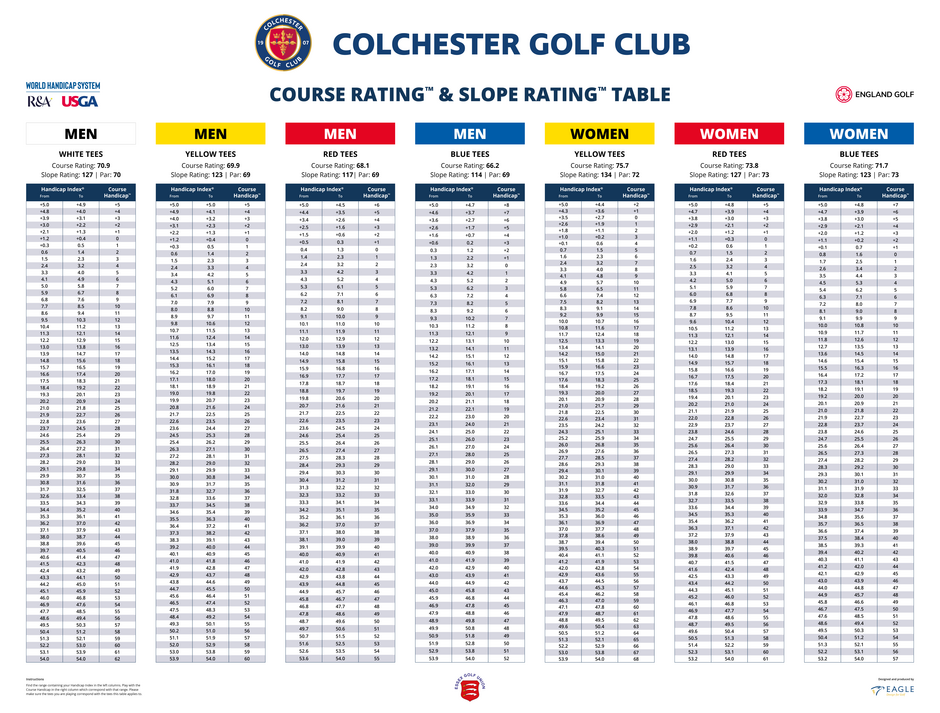WHS Index


View CGC WHS Slope Rating Panel
To view Handicap Allowances under WHS
1. When does the new World Handicap System come into place?
Any golfer with a current CONGU handicap will be given a World Handicap System index on Monday November 2, 2020.
2. Is the new golf handicap system mandatory?
Yes. In Great Britain & Ireland, the current handicapping system, which is maintained by CONGU, will be replaced by one single, global system. It is designed so golfers will be able to obtain and maintain a handicap index and use this to compete on a fair and equal basis across any format, on any course around the world.
3. How will my new handicap be calculated?
Start with your handicap index. This will form the basis for your course and playing handicap. Every score in a player's handicap record will be converted to a score differential. This is calculated by multiplying the difference between your gross score and the course rating by 113 and dividing by the slope rating of the tees that were played.
That figure then goes forward into a pool of the player's 20 most recent scores. The best eight are then selected and a simple average is taken to calculate every golfer's handicap index.
Easy, eh? Luckily, you won't have to worry about this, as the World Handicap System will do all the hard work for you.
4. Is my handicap likely to change much with the new system?
While testing the new system, England Golf found that the handicap index of most players was within one stroke of their existing CONGU handicap.
5. What's the difference between 'course handicap' and 'playing handicap'?
Slope rating and course rating are used to determine your course handicap, which represents the number of strokes a player receives from any given set of tees prior to the terms of the competition. If a handicap allowance is applied, the adjusted course handicap is defined as a playing handicap, which represents the number of strokes a player gives or receives for the competition.
6. How will my course handicap be calculated?
Clubs will either provide you with a "˜handicap calculation conversion table' or you will be directed to your golf union's website, where all slope ratings will be listed and a calculator is provided. You will also be able to do it manually by multiplying your handicap index by the course's slope rating, divided by the "neutral" slope of 113.
7. Why is the neutral slope 113?
The USGA considers this to be a course of "standard playing difficulty", though England Golf claim the average GB&I slope rating is 125.
8. Hang on... what is a slope rating?
It indicates the standard difficulty of a golf course for the "bogey golfer" relative to the scratch player. Every set of tees will have a slope rating and those numbers will vary between 55 and 155. The higher the slope rating, the greater the difference expected between the scores of those scratch and bogey golfers.
9. What is a 'bogey golfer'?
This is the term used when carrying out a course rating. It represents the ability of a golfer (20 handicap for men, 24 for women) on a course of average difficulty.
10. Does a higher slope rating mean a golf course is more difficult?
No. A course rating, which indicates the number of strokes the scratch golfer is expected to take under normal playing conditions, is the core evaluation of a course's difficulty. It's important to remember that the course rating affects a player's index far more than the slope number.
11. How are golf courses rated?
All courses are rated under the USGA Course Rating System. There are five factors that are considered for each hole. These are:
- Roll: Assessment of how far a ball will roll on fairways with various surface conditions/contouring.
- Elevation: Difference in elevation between the tee and green and for a player's approach shot to the green.
- Wind: Average wind strength and direction.
- Forced lay-up: Where a player is forced to play short of obstacles that cross the fairway.
- Dog-leg: Where the dog-leg design of a hole does not allow a full tee shot to be played.
There are also 10 other obstacles that are evaluated on each hole:
- Topography: Nature of the stance and lie within each landing zone and approach shot elevation to the green.
- Fairway: The width of fairway landing zones, hole length and nearby obstacles, including trees, hazards and rough.
- Green target: Evaluation of hitting the green with the approach shot and the visibility and nature of the green surface.
- Recoverability and rough: Difficulty of recovery if the tee shot landing zone and/or the green is missed.
- Bunkers: The size, depth and proximity to the landing zone and green.
- Crossing obstacle: Shot length to safely carry water, penalty areas, out of bounds or extreme rough.
- Lateral obstacle: The distance of obstacles from the centre of the fairway and green.
- Trees: The size, density and proximity of trees to the centre of the landing zone/green, shot length to target areas, and recovery difficulty.
- Green surface: Putting difficulty on a green. This takes into account green speed, surface contours and tiers.
- Psychological: Evaluation of the cumulative effect of the other nine obstacle factors.
Each obstacle is given a numerical value, from 0 to 10 (0 being non-existent, 10 being extreme). The process is repeated on every hole and for every tee. Through this data, a scratch and bogey rating is achieved.
12. Do I need to play a certain number of rounds per year?
Scores will not expire, but your handicap index will only be valid if you're a member of an affiliated golf club. To maintain an accurate handicap, it is recommended that players return at least 20 scores over a two-year period.
13. What if you are new to golf? How would you obtain a handicap index?
By submitting scores of 3 x 18 holes, 6 x 9 holes or a combination of both. Revisions will be daily, so once they've submitted scorecards totalling 54 holes or more, an initial handicap index will be awarded and based on an adjusted average relative to the number of scores that have been submitted. This will continue until a fully-developed handicap with 20 scores on record is achieved.
14. Will I be able to play off any tee?
You will be able to return scores from any tee that has a course and slope rating for your gender.
15. Do I have to submit my score from every round of golf I play?
It will be mandatory to submit all singles competition scores, but you will have the option to submit social/recreational scores, as long as they are pre-registered and conform to the Rules of Handicapping and Rules of Golf. Each time a score is submitted, your handicap index will be recalculated and updated for the next day of play, or soon after.
16. Will I use my handicap index or course handicap for competitions?
Competition entry (eligibility) will be based on your handicap index. The committee in charge of a competition may set eligibility conditions within their terms of the competition. For example:
- A maximum handicap index limit for entry.
- A maximum course handicap limit.
- A maximum playing handicap.
17. Will there still be a competition standard scratch (CSS) score?
No, but a playing conditions calculation (PCC) will adjust score differentials when abnormal course conditions cause scores to be unusually high or low. This will be based on how players have performed compared to their expected performance on that golf course.
18. How is the PCC calculated if only one player submits a score for handicap purposes?
The PCC can only take place if at least eight acceptable scores have been submitted by players with a fully-developed handicap index of 36.0 or below. It is then applied retrospectively, after your score is posted, within the calculation of score differentials for all players.
- A 0.0 adjustment means the course played as expected.
- A -1.0 adjustment means the course played easier than normal.
- A +1.0, +2.0 or +3.0 adjustment means the course played more difficult than normal.
19. But what happens if the weather is different in the morning and afternoon?
Only one PCC calculation will take place, so both sets of conditions will be taken into consideration, similar to the existing CSS calculation.
20. Will buffer zones and annual handicap reviews still exist?
Annual reviews will, but buffer zones will not.
21. If I hit two shots out of bounds and pick up on that hole, will I still be able to submit my score?
Yes. When the format of play allows, you are encouraged to pick up once you have reached your maximum hole score for handicap purposes - which is a nett double bogey.
22. What happens if I fail to complete a full nine-hole or 18-hole round because of fading light?
If you fail to play the minimum number of holes required, the score is disregarded. For a nine-hole round, all nine holes must be completed. For an 18-hole round, at least 10 holes must be completed. If you play more than 10 holes but less than 14, you will be allocated nett par plus one stroke for the first hole not played and then nett par for the remaining holes. If you play 14 or more holes, you will be allocated nett par for the remaining holes.
23. If I submit a 'no return' (NR), will I get a 0.1 increase on my handicap?
There are no 0.1 increases under the WHS. A hole that is started but not completed will be recorded as a nett double bogey. Any holes not played will be allocated as a nett par, and added to your record.
Exception: If you complete more than 10 holes but less than 14 holes in an 18-hole round, nett par plus one stroke must be added to the first hole not played.
24. What would happen if there is a delay in a score being returned, either due to tardiness or technical problems?
Scores should be entered before midnight on the same day. Any scores not entered before that time will still be acceptable but will not be used as part of the PCC.
25. How will WHS prevent handicap manipulation?
If a player fails to submit a pre-registered score, the handicap committee will investigate and take appropriate action. They have the option to apply penalty scores, reset a handicap index, consider disciplinary action, or withdraw a handicap index for an agreed period.
26. For multi-round events such as a club championship, will I use my initial handicap index for each round?
The WHS recommends that the handicap index at the start of the competition is used for each round of the event. However, this must be stated in the terms of competition, and your committee will have the final say.
27. Will all golf courses in Great Britain & Ireland have their slope and course ratings completed in time?
Scottish Golf have completed theirs, but England Golf expect to have rated "between 70-75 per cent" of courses by November 2020. The remaining courses will be assigned a provisional rating in the short term and rated in 2021.
28. Will there still be exceptional scoring reductions (ESR)?
Yes, but only if a player submits a score that produces a score differential that is seven strokes or more below their handicap index.
- If the score is 7.0 - 9.9 strokes better: A -1.0 handicap index adjustment will be applied.
- If the score is 10.0 or more strokes better: A -2.0 handicap index adjustment will be applied.
29. Can I use my handicap abroad?
Yes, your handicap index will be converted to a course handicap for the course (and tees) you are using on the day. If pre-registered, these scores can be returned to your home club for handicap purposes.
30. How much is my handicap likely to increase or decrease under the World Handicap System?
There is no limit by which a player's handicap index can decrease - but a soft cap will "suppress" any increase when the difference between a player's newly-calculated handicap index and their lowest handicap index in the last 12-month period is greater than three.
This will work by reducing the value of any increase over 3.0 by 50 per cent, so a player's handicap index will better reflect their underlying ability, rather than a bad run of form. As a second safeguard, a hard cap will then limit any "extreme upward movements" to five strokes.











